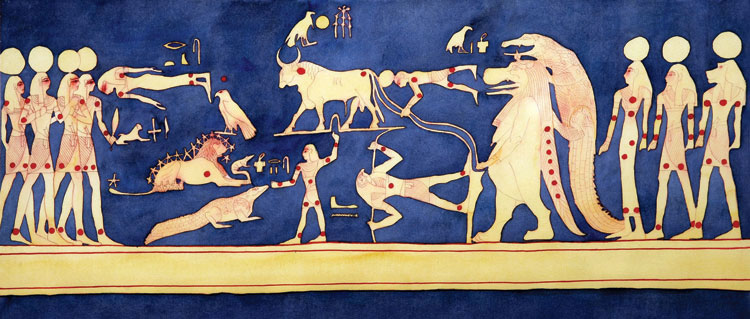One People, One Planet, HON!Seti I Ceiling (detail) |
|
1980, watercolor, pen and ink, 19¼” x 40½” Thanks to the support of President Sadat the Hieronimuses had personal and private access to several tombs and temples that were not open to the public. They were permitted to stay in the tombs of King Tutankhamen and Seti I for hours, allowing them to examine in great detail the artifacts and murals. This Hieronimus watercolor is based on what he considered to be the most beautiful of all early Egyptian constellations in the Valley of the Kings. They found it on the ceiling in the Tomb of Seti I, the 2nd king of the 19th dynasty (c. 1303-1290 BC). The Egyptians depicted “astronomical ceilings” in various tombs and temples that differ between themselves somewhat, but together show a good approximation of how the Egyptians identified with the night sky. Usually their constellations were very large and included the Hippopotamus (identified with the goddess Isis), Ox, and Crocodile. Though it is difficult to match up their constellations with modern ones, two are very similar to the Western constellations of Orion and Ursa Major. The northern group of constellations also included the Lion, Crocodile, the Bull’s foreleg (also represented as a complete Bull, and thought to be the “big dipper”), the Boatman, a giant man, and a huge female hippopotamus with a crocodile tail (or an entire crocodile) on her back. The Hippopotamus-crocodile was commonly identified with the stars of Draco, the Dragon, and together with the Giant Man took up about half the sky. By this time in his career, Hieronimus was a serious student of astrology, and learning how ancient cultures had depicted their understanding and interpretation of the stars further added to his palette of symbolism. To this day, he never schedules an important meeting without first considering the astrological conditions.
|
